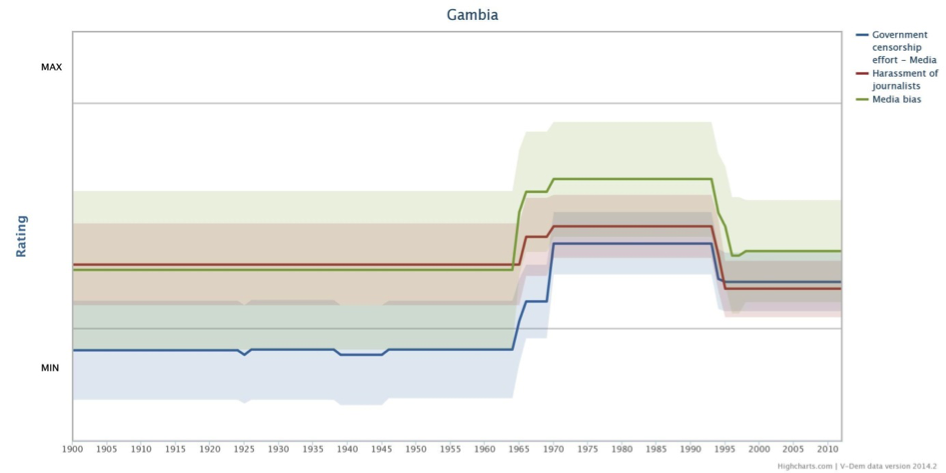Media freedom the Gambia
By: V-Dem Staff
Feb 04, 2015
Three of them are graphed below for Gambia starting from 1900 until 2012. Based on the assessments of multiple experts, these indicators capture the extent to which the government directly or indirectly attempts to censor the media, whether individual journalists are harassed by governmental or powerful non-governmental actors while engaged in legitimate journalistic activities, and finally, if the media is biased against opposition parties or their candidates.
A maximum score on these indicators suggests that journalists can exercise their profession freely and that the media is more or less politically impartial. It can be noted that during the whole period graphed, the levels of media freedom in Gambia are quite low, with the exception of the period between 1965 and 1994 when a steep increase of scores can be noticed on all three indicators. The last downward trend starting from 1994 coincides with the incumbent Gambian President Yahya Jammeh taking power in a military coup. Although the President was elected through direct vote in 2001, 2006 and 2011, the regime has been criticized by a number of human rights organizations for failing to meet various democratic norms, and as the graph shows, media freedom is one of the affected areas.
The V-Dem dataset contains ten different indicators measuring different aspects of media freedom. Three of them are graphed below for Gambia starting from 1900 until 2012. Based on the assessments of multiple experts, these indicators capture the extent to which the government directly or indirectly attempts to censor the media, whether individual journalists are harassed by governmental or powerful non-governmental actors while engaged in legitimate journalistic activities, and finally, if the media is biased against opposition parties or their candidates. A maximum score on these indicators suggests that journalists can exercise their profession freely and that the media is more or less politically impartial. It can be noted that during the whole period graphed, the levels of media freedom in Gambia are quite low, with the exception of the period between 1965 and 1994 when a steep increase of scores can be noticed on all three indicators. The last downward trend starting from 1994 coincides with the incumbent Gambian President Yahya Jammeh taking power in a military coup. Although the President was elected through direct vote in 2001, 2006 and 2011, the regime has been criticized by a number of human rights organizations for failing to meet various democratic norms, and as the graph shows, media freedom is one of the affected areas.


